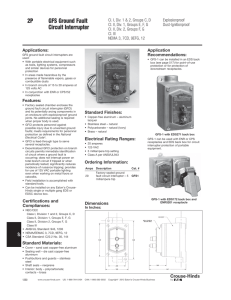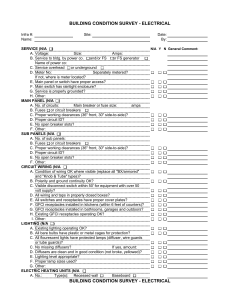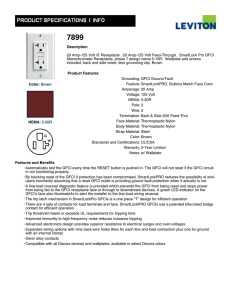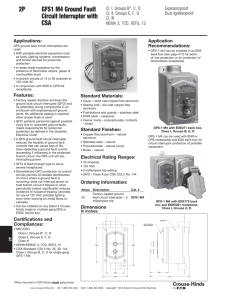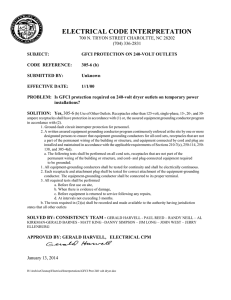Ground Fault Circuit Interrupter
advertisement
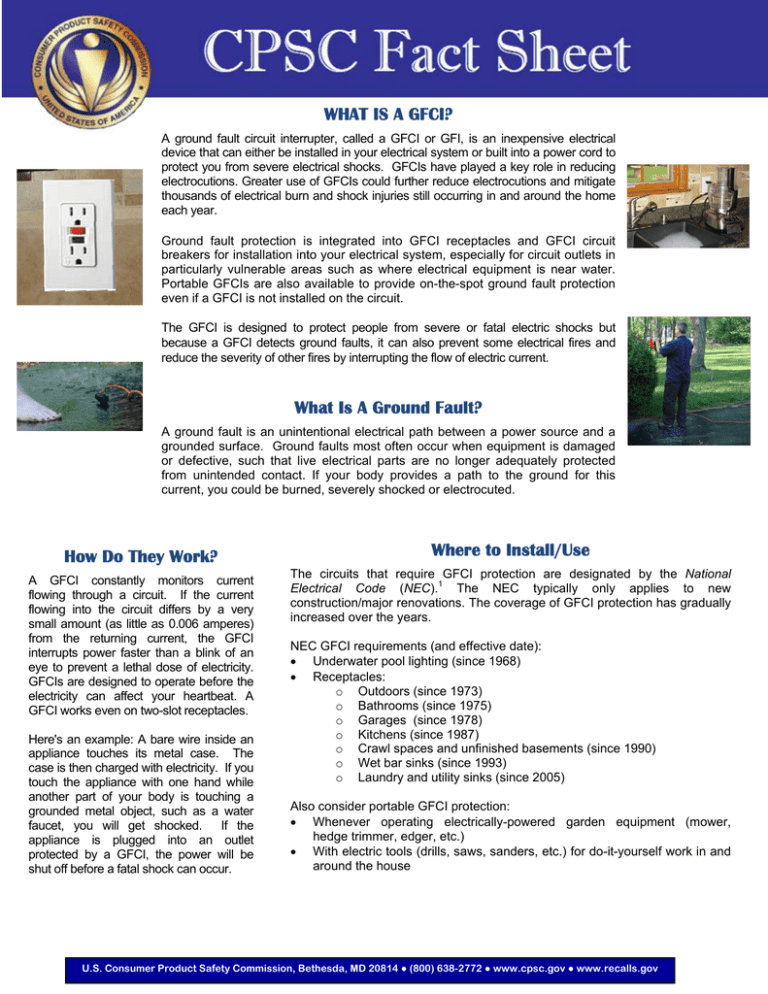
WHAT IS A GFCI? A ground fault circuit interrupter, called a GFCI or GFI, is an inexpensive electrical device that can either be installed in your electrical system or built into a power cord to protect you from severe electrical shocks. GFCIs have played a key role in reducing electrocutions. Greater use of GFCIs could further reduce electrocutions and mitigate thousands of electrical burn and shock injuries still occurring in and around the home each year. Ground fault protection is integrated into GFCI receptacles and GFCI circuit breakers for installation into your electrical system, especially for circuit outlets in particularly vulnerable areas such as where electrical equipment is near water. Portable GFCIs are also available to provide on-the-spot ground fault protection even if a GFCI is not installed on the circuit. The GFCI is designed to protect people from severe or fatal electric shocks but because a GFCI detects ground faults, it can also prevent some electrical fires and reduce the severity of other fires by interrupting the flow of electric current. What Is A Ground Fault? A ground fault is an unintentional electrical path between a power source and a grounded surface. Ground faults most often occur when equipment is damaged or defective, such that live electrical parts are no longer adequately protected from unintended contact. If your body provides a path to the ground for this current, you could be burned, severely shocked or electrocuted. How Do They Work? A GFCI constantly monitors current flowing through a circuit. If the current flowing into the circuit differs by a very small amount (as little as 0.006 amperes) from the returning current, the GFCI interrupts power faster than a blink of an eye to prevent a lethal dose of electricity. GFCIs are designed to operate before the electricity can affect your heartbeat. A GFCI works even on two-slot receptacles. Here's an example: A bare wire inside an appliance touches its metal case. The case is then charged with electricity. If you touch the appliance with one hand while another part of your body is touching a grounded metal object, such as a water faucet, you will get shocked. If the appliance is plugged into an outlet protected by a GFCI, the power will be shut off before a fatal shock can occur. Where to Install/Use The circuits that require GFCI protection are designated by the National Electrical Code (NEC).1 The NEC typically only applies to new construction/major renovations. The coverage of GFCI protection has gradually increased over the years. NEC GFCI requirements (and effective date): Underwater pool lighting (since 1968) Receptacles: o Outdoors (since 1973) o Bathrooms (since 1975) o Garages (since 1978) o Kitchens (since 1987) o Crawl spaces and unfinished basements (since 1990) o Wet bar sinks (since 1993) o Laundry and utility sinks (since 2005) Also consider portable GFCI protection: Whenever operating electrically-powered garden equipment (mower, hedge trimmer, edger, etc.) With electric tools (drills, saws, sanders, etc.) for do-it-yourself work in and around the house U.S. Consumer Product Safety Commission, Bethesda, MD 20814 ● (800) 638-2772 ● www.cpsc.gov ● www.recalls.gov How to Install Circuit breaker and receptacle-type GFCIs may be installed in your home by a qualified electrician. Receptacle-type GFCIs may be installed by consumers with adequate knowledge and skills to conform to proper electrical wiring practices and the instructions accompanying the device. When in doubt about the proper procedure, contact a qualified electrician; do not attempt to install it yourself. RECEPTACLE Used in place of the standard duplex receptacle. Fits into a standard outlet box and protects against ground-faults for whatever is plugged into the outlet and other electrical outlets further "down stream" in the branch circuit. Can even replace older ungrounded, twoslot receptacles with new GFCI receptacles. Must use supplied label “NO EQUIPMENT GROUND GFCI PROTECTED” to identify that the receptacle is not grounded. A portable GFCI gets plugged into a receptacle just like any other cord-and-plug-connected device. How to Test Test every GFCI: After installation At least once a month After a power failure2 According to the manufacturer’s instructions. If you do not have the instructions follow this procedure: o Plug a lamp into the outlet and turn the lamp on. o Press the GFCI’s test button. Did the light go out? If not, the GFCI is not working or has not been correctly installed. Contact a qualified electrician to correct the wiring and/or replace the defective GFCI. o Press the reset button. Did the light come back on? If not, replace the GFCI. RESET TEST PORTABLE Used where installed GFCIs are not practical. One type contains the GFCI circuitry in a plastic enclosure with plug blades in the back and receptacle slots in the front. It can be plugged into a receptacle, then the electrical product is plugged into the GFCI. Another type of portable GFCI is an extension cord combined with a GFCI. It adds flexibility in using receptacles that are not protected by GFCIs. Types of GFCIs CIRCUIT BREAKER A circuit breaker with a built-in GFCI may be installed in a panel box to add protection to the circuits it supplies. Protects against both a ground fault and a circuit overload Protects the wiring and every outlet, lighting fixture, or appliance on the branch circuit that it supplies. 1 The NEC is published by the National Fire Portection Association (NFPA 70). It is the most widely adopted building code for requirements for electrical system installations in the U.S. It may be adopted into law by states, counties or local jurisdictions for enforcement by inspection authorities and is currently revised every three years. 2 Blackouts and other power disturbances can sometimes damage a GFCIs ability to function properly. 092010 Pub. 099 U.S. Consumer Product Safety Commission, Bethesda, MD 20814 ● (800) 638-2772 ● www.cpsc.gov ● www.recalls.gov
